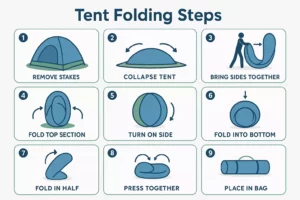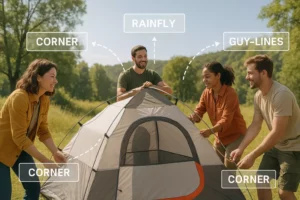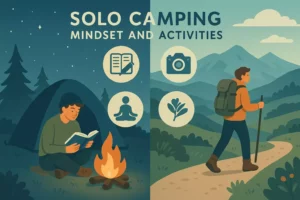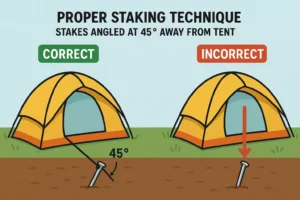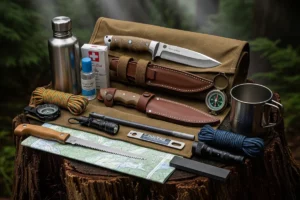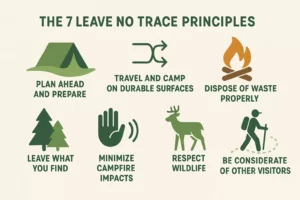Bear Safety for Campers: A Practical Guide to Storage, Smells, and Encounters
The morning mist rises from the lake as you unzip your tent, only to find massive paw prints circling your campsite. Your heart pounds as you realize a bear visited during the night, drawn by the scent of last night’s s’mores still lingering in the air. This scenario, while frightening, is entirely preventable with proper bear safety knowledge.
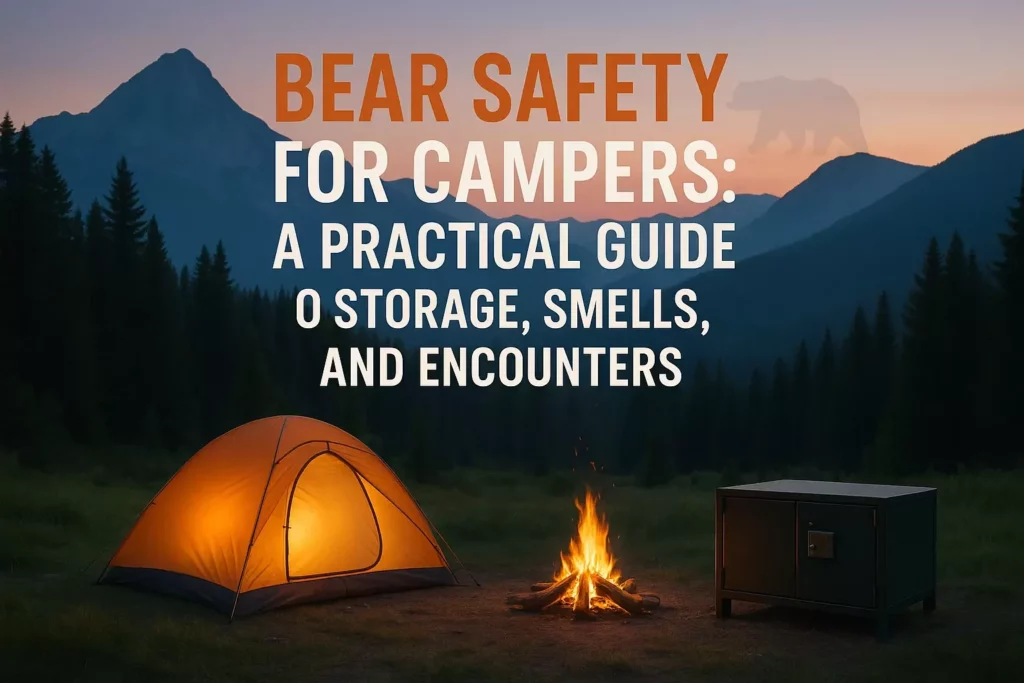
Every year, thousands of camping trips are disrupted—or worse—by preventable bear encounters. The good news? Learning how to be bear safe when camping isn’t complicated, but it requires preparation, awareness, and respect for these powerful wilderness neighbors. Whether you’re planning your first backcountry adventure or you’re a seasoned camper looking to brush up on safety protocols, this comprehensive guide will equip you with the knowledge to camp confidently in bear country.
Key Takeaways
- Proper food storage is your first line of defense—use bear canisters, hang food at least 12 feet high and 6 feet from tree trunks, or utilize designated bear lockers
- Maintain a clean campsite by cooking and eating 100+ yards from your sleeping area, and never store scented items in your tent
- Make noise while hiking to avoid surprising bears, and always carry bear spray as a last resort for close encounters
- Know the difference between black bear and grizzly bear behavior—each species requires different response strategies during encounters
- Follow the bear encounter hierarchy: back away slowly, avoid eye contact, make yourself appear large, and play dead only with defensive grizzly attacks
Understanding Bear Behavior and Habitat
Types of Bears in North America
Black Bears 🐻
Black bears are the most common species campers encounter across North America. Despite their name, they can range in color from black to brown, cinnamon, or even blonde. These adaptable omnivores typically weigh 125-250 pounds and are excellent climbers. Black bears are generally more timid around humans but can become aggressive when protecting cubs or food sources.
Grizzly Bears (Brown Bears) 🐻
Grizzly bears inhabit Alaska, western Canada, and parts of the northwestern United States. Significantly larger than black bears, adult grizzlies can weigh 300-800 pounds. They’re distinguished by their shoulder hump, longer claws, and dished face profile. Grizzlies are more aggressive than black bears and require different safety protocols.
What Attracts Bears to Campsites
Bears possess an incredible sense of smell—seven times stronger than a bloodhound’s. They can detect food odors from miles away, making campsites prime targets for investigation. Common attractants include:
- Food and beverages (including pet food)
- Toiletries and cosmetics (toothpaste, deodorant, soap)
- Cooking utensils and dishes with food residue
- Garbage and food wrappers
- Scented items (sunscreen, insect repellent, feminine hygiene products)
“A fed bear is a dead bear” – This wildlife management saying emphasizes that bears who associate humans with food often become dangerous and must be relocated or euthanized.
Essential Bear Safety Equipment
Bear Spray: Your Last Line of Defense
Bear spray is a specialized form of pepper spray designed specifically for deterring aggressive bears. It creates a wide spray pattern (up to 30 feet) and contains oleoresin capsicum at concentrations proven effective against bears.
Key Features to Look For:
- EPA registration for use on bears
- Minimum 7.9-ounce canister size
- 30-foot spray distance
- 2% capsaicin concentration
Proper Carry and Use:
- Keep bear spray easily accessible (not buried in your pack)
- Practice using the safety mechanism before your trip
- Replace expired canisters (typically 3-4 year shelf life)
- Aim slightly downward to account for the spray’s trajectory
Food Storage Solutions
Bear Canisters
Hard-sided bear canisters are the gold standard for backcountry food storage. These containers are designed to be bear-proof while remaining human-accessible.
Popular Models:
- BearVault BV500: Lightweight, clear walls for easy packing
- Garcia Backpackers’ Cache: Smaller profile, fits most backpacks
- UDAP No-Fed-Bear: Budget-friendly option with proven effectiveness
Bear Bags and Rope Systems
When bear canisters aren’t required, proper food hanging techniques can protect your supplies.
The Perfect Hang Requirements:
- 12 feet high from the ground
- 6 feet from tree trunk
- 5 feet below branch
- Use paracord or specialized bear rope (minimum 50 feet)
Having the right gear is crucial, but it’s equally important to know how to pack your backpack for camping efficiently to accommodate these safety items without compromising your trip.
How to Be Bear Safe When Camping: Food Storage Strategies
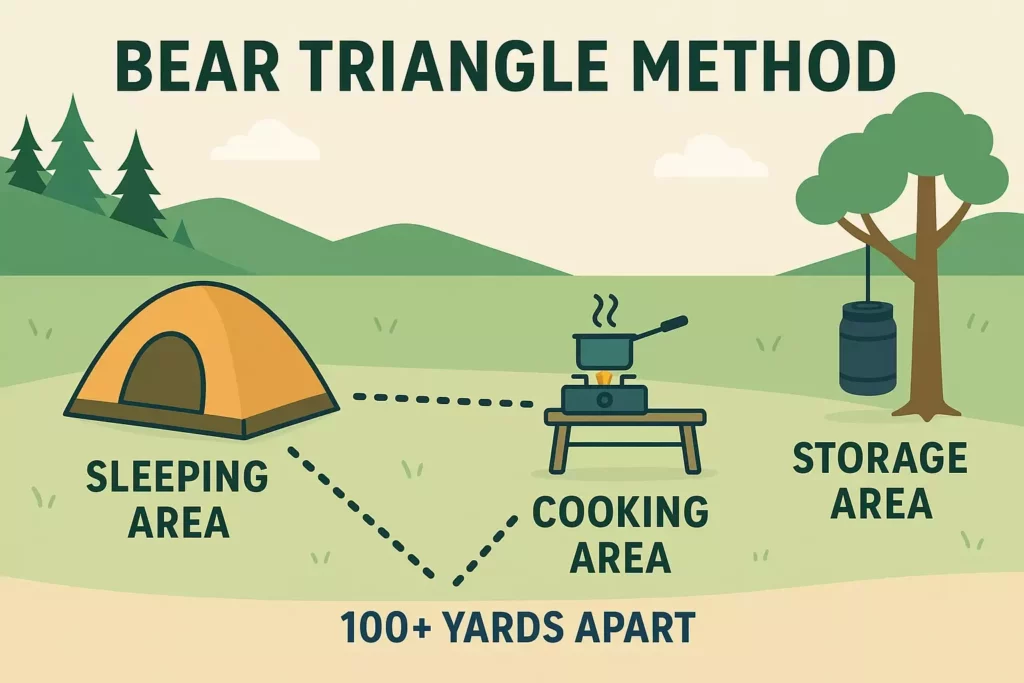
The Bear Triangle Method
The bear triangle is a fundamental principle for campsite organization in bear country. This method involves creating three distinct areas, each at least 100 yards apart:
- Sleeping Area: Your tent and sleeping gear only
- Cooking Area: Food preparation, eating, and cleanup
- Storage Area: Where you hang food, store garbage, and keep scented items
This separation ensures that food odors don’t concentrate near your sleeping area, reducing the likelihood of a bear encounter during the night.
Campsite Food Management
Before Cooking:
- Set up your cooking area downwind from your tent
- Lay out a tarp to catch food spills
- Prepare only what you’ll eat to minimize leftovers
During Meals:
- Never leave food unattended, even briefly
- Keep cooking areas clean as you work
- Store opened food immediately after use
After Eating:
- Wash dishes immediately with hot, soapy water
- Strain dishwater and pack out food particles
- Store clean dishes with your food supplies (they retain odors)
Approved Food Storage Methods:
| Method | Best For | Pros | Cons |
|---|---|---|---|
| Bear Canisters | Backcountry camping | Foolproof, portable | Heavy, limited space |
| Bear Lockers | Developed campgrounds | Spacious, convenient | Only at certain sites |
| Proper Hanging | Areas without facilities | Lightweight, flexible | Weather dependent, skill required |
| Vehicle Storage | Car camping | Easy access | Must be hard-sided vehicle |
What NOT to Store in Your Tent
Never bring these items into your sleeping area:
- Any food or beverages (including water bottles used for cooking)
- Toiletries and personal care items
- Clothes worn while cooking
- Trash or food wrappers
- Pet food or treats
- Medications with strong scents
- Feminine hygiene products
Campsite Setup and Maintenance
Choosing Bear-Safe Campsites
Look for these characteristics:
- Open areas with good visibility in all directions
- Established campsites with existing fire rings and bear storage
- Areas without recent bear sign (tracks, scat, claw marks on trees)
- Distance from water sources where bears commonly travel
- Avoid berry patches or other natural food sources
Red Flags to Avoid:
- Dense vegetation that could conceal a bear’s approach
- Game trails or obvious animal paths
- Areas with scattered garbage or food remnants
- Campsites with damaged bear boxes or storage facilities
Maintaining a Clean Camp
Daily Cleaning Routine:
- Immediate cleanup after each meal
- Burn food scraps completely in hot fires (where permitted)
- Pack out all garbage in sealed containers
- Wipe down surfaces to remove food residue
- Change clothes after cooking before sleeping
When camping with kids, maintaining cleanliness becomes even more critical, as children may inadvertently leave food scraps or sweet-smelling items around the campsite.
Hiking and Trail Safety in Bear Country
Making Noise: Your First Defense
Why noise matters: Most bear encounters occur when bears are surprised. Bears typically avoid humans when they know we’re present.
Effective noise-making techniques:
- Talk loudly or sing while hiking
- Clap hands regularly, especially near blind corners
- Use bear bells (though voices are more effective)
- Travel in groups when possible—larger groups make more noise naturally
When to be extra noisy:
- Dense vegetation or limited visibility
- Near streams or waterfalls (which mask sound)
- Windy conditions
- Dawn and dusk when bears are most active
Trail Awareness and Observation
Watch for bear sign:
- Fresh tracks in mud or soft earth
- Scat (droppings) containing berries, nuts, or fur
- Claw marks on trees at eye level or higher
- Torn logs or overturned rocks (bears searching for insects)
- Day beds or flattened areas where bears have rested
Environmental awareness:
- Scan ahead constantly while hiking
- Pay attention to bird and wildlife behavior (sudden silence or agitation)
- Be especially cautious around carcasses or strong odors
- Give wide berth to cubs—mother bears are always nearby
A well-prepared first aid kit should be part of your bear country hiking gear, as injuries can occur during encounters or while trying to avoid them.
Bear Encounter Protocols
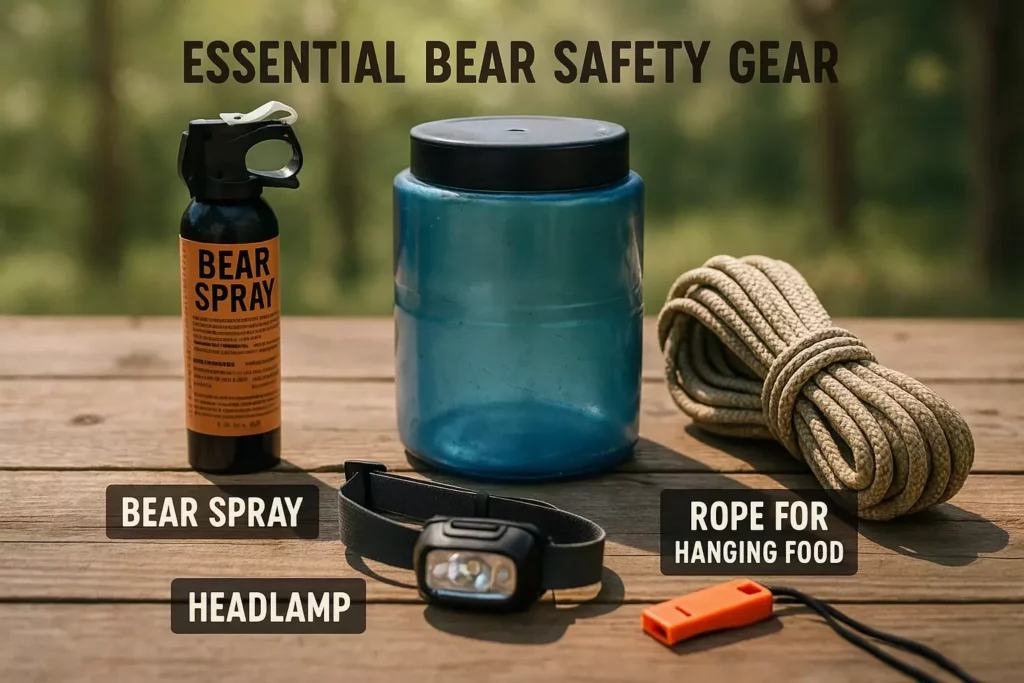
Prevention is Key
The hierarchy of bear safety:
- Avoid encounters through proper camping practices
- Detect bears early through awareness and noise
- Respond appropriately if an encounter occurs
- Use bear spray as a last resort
- Fight back only if attacked by a black bear
If You See a Bear at a Distance
Immediate actions:
- Stop and assess the situation calmly
- Back away slowly while keeping the bear in sight
- Make yourself known by speaking in a calm, loud voice
- Give the bear space to escape—never corner a bear
- Take a detour or wait for the bear to leave
What NOT to do:
- Run (bears can reach 35 mph)
- Make direct eye contact
- Make sudden movements
- Approach for photos or videos
Close Encounter Responses
For Black Bears:
- Stand your ground and make yourself appear large
- Raise your arms or jacket above your head
- Back away slowly while facing the bear
- Make noise by yelling or banging objects
- Prepare bear spray if the bear approaches within 30 feet
- Fight back if physically contacted—black bears often bluff
For Grizzly Bears:
- Avoid eye contact (seen as aggressive)
- Speak softly and back away slowly
- Play dead if the bear makes contact (lie on stomach, protect neck)
- Use bear spray when bear is within 20-30 feet
- Fight back only if the attack continues after playing dead
🐻 Bear Encounter Decision Tool
Answer the questions to get specific safety recommendations
What type of bear did you encounter?
Your Recommended Actions
Regional Bear Safety Considerations
Popular Camping Destinations and Their Bear Populations
Yellowstone National Park
- Species: Both black bears and grizzlies
- Special requirements: Hard-sided storage mandatory
- Peak activity: May through October
- Regulations: $5,000 fine for improper food storage
Great Smoky Mountains
- Species: Black bears only
- Population: Over 1,500 bears in the park
- Common issues: Bears conditioned to human food
- Best practices: Use provided bear cables and lockers
Alaska Wilderness
- Species: Brown bears (coastal) and black bears
- Special considerations: Larger brown bears, salmon runs
- Recommended gear: Large bear spray canisters, electric fences
- Timing: Extra caution during berry season (July-August)
Seasonal Bear Behavior Patterns
Spring (March-May)
- Bears emerge from hibernation, extremely hungry
- Mothers with new cubs are particularly protective
- Natural food sources are limited
- Extra precautions needed
Summer (June-August)
- Peak camping season coincides with active bear period
- Bears focus on high-calorie foods (berries, nuts, fish)
- Increased human-bear interactions
- Maintain constant vigilance
Fall (September-November)
- Hyperphagia: Bears enter intensive feeding mode before winter
- Most aggressive food-seeking behavior
- Bears may take greater risks around humans
- Highest risk period for encounters
For families planning trips during peak bear season, understanding family camping activities that minimize food-related attractions becomes especially important.
Emergency Response and First Aid
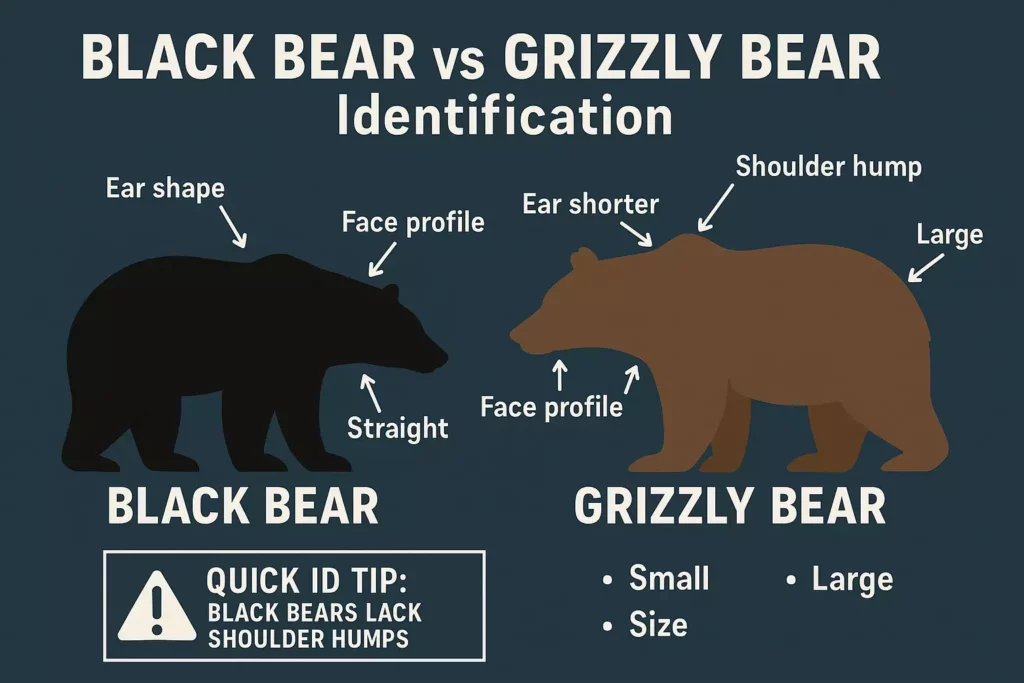
Immediate Post-Encounter Actions
If No Injuries Occurred:
- Move to safety immediately
- Report the encounter to park rangers or local authorities
- Document details: time, location, bear behavior, circumstances
- Warn other campers in the area
- Reassess your camping practices that may have contributed
If Injuries Occurred:
- Ensure scene safety before providing aid
- Call for emergency help immediately (911 or park emergency number)
- Provide first aid for wounds and shock
- Control bleeding with direct pressure
- Treat for shock – keep victim warm and calm
Essential First Aid for Bear Encounters
Wound Care Priorities:
- Stop bleeding using direct pressure and elevation
- Clean wounds with clean water when bleeding is controlled
- Cover with sterile dressings to prevent infection
- Monitor for signs of shock (pale skin, rapid pulse, confusion)
Psychological First Aid:
- Bear encounters are traumatic experiences
- Provide reassurance and emotional support
- Stay with the victim until professional help arrives
- Document everything for medical professionals
A comprehensive survival kit should include supplies for treating serious wounds that could result from wildlife encounters.
Advanced Bear Safety Techniques
Group Camping Strategies
Communication Systems:
- Establish clear signals for bear sightings
- Assign roles for food storage and cleanup
- Create buddy systems for hiking and camp tasks
- Practice emergency procedures before the trip
Coordinated Food Management:
- Designate one person as “bear safety coordinator”
- Centralize cooking in one location
- Synchronize meal times to minimize exposure periods
- Share storage containers to reduce scent points
Technology and Bear Safety
GPS and Communication:
- Satellite communicators for emergency contact in remote areas
- GPS coordinates for precise location reporting
- Weather alerts that might affect bear behavior
- Emergency beacon activation procedures
Motion Detection:
- Trail cameras can monitor campsite approaches
- Motion-activated lights may deter nighttime visits
- Perimeter alarms for early warning systems
Teaching Children About Bear Safety
Age-Appropriate Education
Young Children (5-8 years):
- Simple rules: “Never feed animals” and “Tell adults about any animals”
- Role-playing games to practice staying calm
- Picture books about wildlife safety
- Basic noise-making techniques
Older Children (9-15 years):
- Detailed bear identification skills
- Proper food storage responsibilities
- Emergency signal knowledge
- Bear spray basics (observation only)
Family Safety Protocols
Pre-Trip Education:
- Watch wildlife videos together
- Practice bear encounter responses at home
- Assign age-appropriate responsibilities
- Review emergency plans repeatedly
During the Trip:
- Constant supervision in bear country
- Clear boundaries for children’s movement
- Regular safety reminders without creating fear
- Positive reinforcement for following protocols
When setting up your first family camp, involving children in bear safety preparations helps them understand the importance of these protocols.
Common Bear Safety Mistakes to Avoid
Critical Errors That Increase Risk
❌ Storage Mistakes:
- Leaving food in tents “just for a few minutes”
- Using soft-sided coolers in vehicles
- Hanging food too low or too close to trees
- Storing toiletries with regular gear
❌ Behavioral Errors:
- Approaching bears for photographs
- Running when encountering a bear
- Making direct eye contact with grizzlies
- Feeding bears (intentionally or accidentally)
❌ Equipment Failures:
- Expired or improperly maintained bear spray
- Inadequate rope or hanging systems
- Damaged bear canisters or lockers
- Insufficient lighting for nighttime tasks
Recovery from Mistakes
If You’ve Made an Error:
- Correct immediately without panic
- Increase vigilance for the remainder of your trip
- Inform your group about the mistake and lessons learned
- Report incidents to authorities if bears were attracted
Conclusion
Learning how to be bear safe when camping isn’t just about following rules—it’s about developing a mindset of respect and coexistence with one of North America’s most magnificent predators. The strategies outlined in this guide, from proper food storage and campsite management to encounter protocols and emergency response, form a comprehensive defense system that allows you to enjoy the wilderness while minimizing risks.
Remember that bear safety is an ongoing practice, not a one-time lesson. Each camping trip offers opportunities to refine your techniques and build confidence in bear country. Whether you’re enjoying a morning meal prepared through campfire cooking or ensuring you have appropriate cool weather clothes for extended wilderness stays, bear safety considerations should be integrated into every aspect of your outdoor adventures.
The wilderness belongs to both humans and bears. By following these proven safety protocols, maintaining clean campsites, and respecting wildlife boundaries, we can ensure that future generations will continue to experience the thrill of camping in bear country. Start implementing these practices on your next trip, share your knowledge with fellow campers, and remember that the best bear encounter is the one that never happens.
Take action today: Review your camping gear for bear safety compliance, practice hanging techniques in your backyard, and ensure your group understands these protocols before your next wilderness adventure. When it comes to learning how to purify water for drinking while camping or choosing the right sleeping bag, bear safety should always be part of your planning process.

